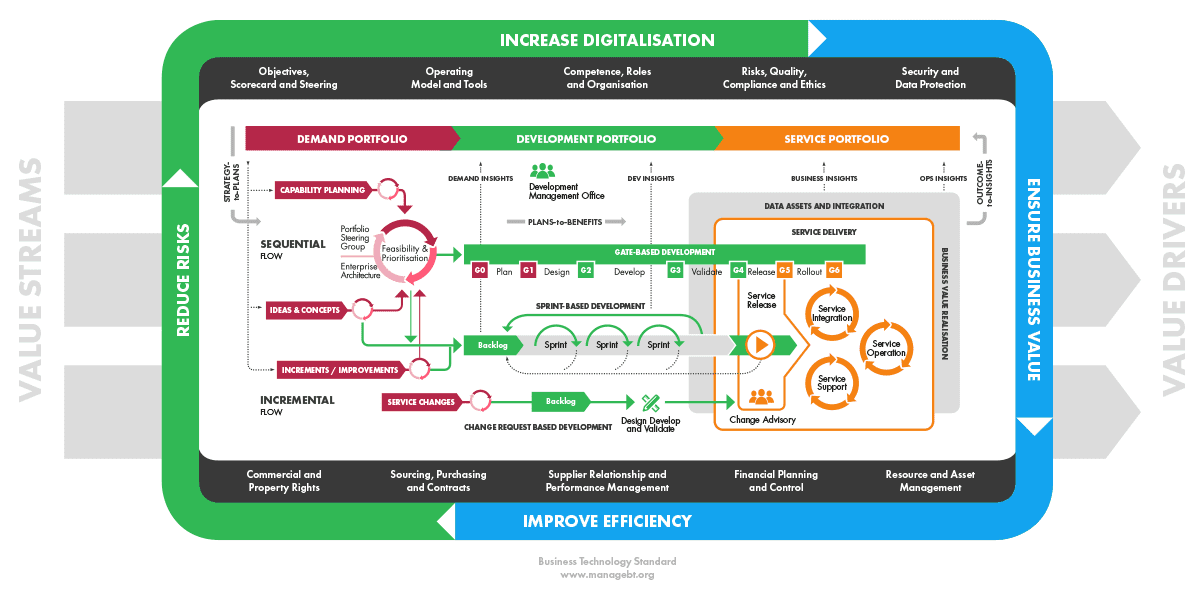Portfolio management ensures that organisations’ strategic intent is met in development. Initiatives with better strategic fit and higher business value are given priority.
Portfolio management includes the following duties:
The full list of development initiatives, either pending, committed or rejected, represent the demand portfolio. Once the initiative gets approved by the portfolio steering, it proceeds to the development portfolio.
Figure 2.6.1 Portfolio management
The development portfolio provides the visibility and guidance necessary to maximise the business value of the development initiatives whilst minimising the administrative burden on those initiatives. This ensures the most efficient path for the release.
In order to maximise efficiency, the Business Technology Standard uses an approach called minimal viable governance that customises the portfolio management practices to suit the different types of initiatives. Whilst larger capability developments can follow a traditional gate-based approach, incremental initiatives and minor changes are usually handled in a dedicated self-managed workstream.
When an approved development initiative is put into the sequential track as a project, the development portfolio follows it until project closure and beyond in the realisation of business value.
Figure 2.6.2 Project portfolio steering
The development portfolio is coordinated by the Development Management Office (DMO). The DMO oversees the resourcing, dependencies and the performance of major development initiatives, while providing the required support and consultation in order to maximise business value creation and minimise risks. It facilitates the activities to validate and prioritise development initiatives to be approved or rejected by the development portfolio steering. The DMO also sets and promotes development practices for company-wide visibility and consistency.
In order to fulfil its responsibilities, it is critical that the DMO either has, or can call upon, the appropriate resources. The DMO represents the technology side of the organisation in addition to business and service stakeholders. In particular, senior representation is critical to making adequate prioritisation judgements and business benefit realisation assessments.
The portfolio steering group includes different stakeholders to cover all aspects of decision making including the following:
Most organisations hold a monthly portfolio steering group meeting, and in some rare occasions where the request impacts the company strategy, escalate decisions to the business technology steering group. In most organisations, programmes must be approved by the business technology steering group as well.
Value streams expect an end-to-end view on portfolios related to all development topics. Different value stream views and consolidated enterprise views use the same data and require a centralised portfolio management tool to share the same information efficiently and in an up-to-date manner.
Figure 2.6.3 Portfolio views
While portfolio steering focuses on major development topics only, the value stream stakeholders have interest to see full picture of all development topics including:
The demand portfolio guidelines establish the optimal approach for any given initiative to follow the sequential, incremental or change channel as appropriate. The DMO is there to assist should the initiative need advice or if it needs to change channel.
Once any initiative is approved via the appropriate channel, the channel’s sub-portfolio applies the relevant minimal viable governance approach to ensure that the initiatives that can, and should, benefit from light-touch governance can proceed quickly through to deployment so the business can start to realise the value.
Regardless of the approach taken, it is the responsibility of the development portfolio to track the ultimate business value realisation for all the initiatives. In this respect the DMO needs to track the initiatives well into the service delivery. This overlaps in timescale with the service portfolio but the two have different focuses during this timeframe: development portfolio on the business benefit realisation, and service portfolio on ensuring services are reliable and constantly fit for their business purpose.
A secondary key role of the DMO is to optimise the number of initiatives being undertaken at any given time. In a challenging business environment, it is essential to make prioritisation decisions that support value creation, and to resist the temptation to simultaneously initiate too many projects coming from the demand funnel. This optimised approach reduces the overall waiting time and shortens the business case realisation time.
Figure 2.6.4 Maximise throughput with selective resourcing
